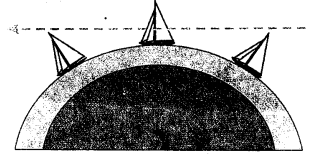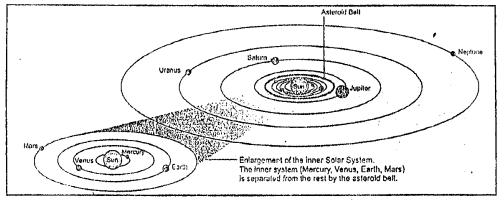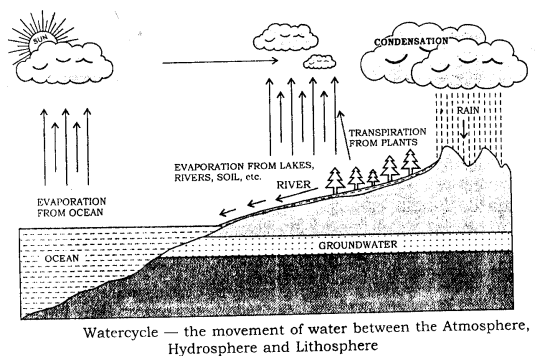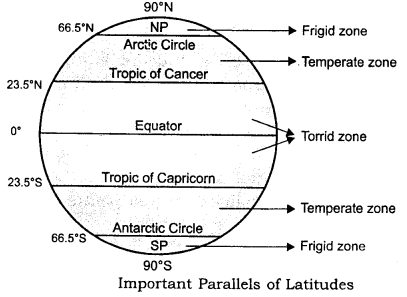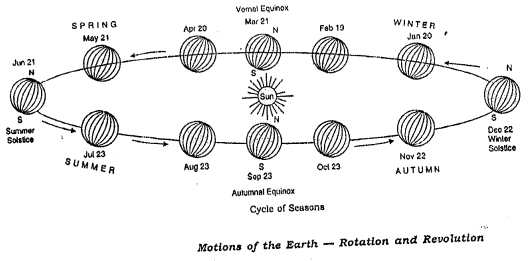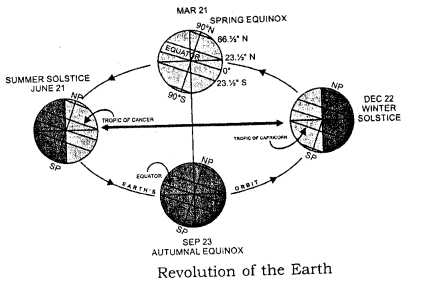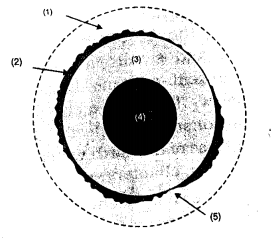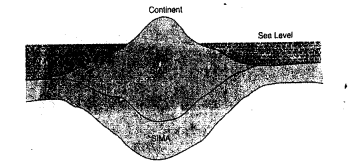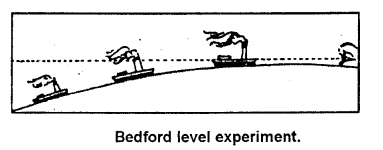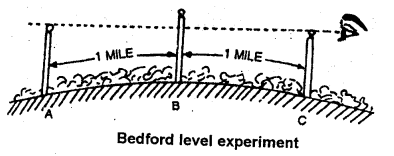ICSE Solutions for Class 9 Geography – Natural Regions of the World
ICSE SolutionsSelina ICSE SolutionsML Aggarwal Solutions
Exercises
I. Short Answer Questions.
Question 1.
Define the term ‘natural region’.
Answer:
A natural region refers to a part of Earth’s surface having a particular uniformity in physical and climatic elements.
Question 2.
Name any four natural regions of the world.
Answer:
Equatorial Region, Tropical Grasslands (Savanah), Tropical Monsoon type and Tropical Deserts.
Question 3.
Briefly state the importance of climate.
Answer:
Climate imparts an important effect on human life, as the life style, occupations, trade facilities all are deeply related to the climatic behaviour of a particular natural region. Climate has a remarkable impact on human efficiency too.
Question 4.
State the location of the Equatorial Region.
Answer:
It is found in Amazon basic, Congo basin and Indonesia etc.
Question 5.
What is the latitudinal extent of the Monsoon climate?
Answer:
Latitudinal extent is from 8°N – 23 1/2° N and 8°S – 23 1/2° S.
Question 6.
Name the two dominant type of vegetation of the Equatorial region.
Answer:
Rubber and ebony.
Question 7.
State the location of the Tropical Desert Climate type.
Answer:
These are located in the western margins of the continents between 15° to 30° North and South Latitudes, where the trade winds blow from land towards sea keeping these areas almost rain less.
Question 8.
What are xerophytic plants ?
Answer:
These plants are leafless to check transpiration and store water in their stems.
Question 9.
What local conditions produce variation in the Mediterranean Type of climate ?
Answer:
It is known for summer drought and winter rain. On account of being located in the zone of Westerlies, the rainfall decreases from coastal parts towards the interior parts. This region is also affected by cold polar winds known as ‘Mistral’ in Rhone valley of France and ‘Bora’ in Greece. Some hot and dry winds also affect North Africa called as ‘Sirrco’ and ‘Khamsin’ in Egypt. These winds increase the temperature and cause damage to crops.
Question 10.
State the rainfall pattern in the Mediterranean climate.
Answer:
Rainfall occurs mostly in winter season. Annual average is from 35 cm to 75 cm. Which is more in the pole ward sides of the region moderate rainfall makes the weather pleasant with sufficient sunny days attract tourists in great numbers to the region.
Question 11.
What type of vegetation is found in the Mediterranean region ?
Answer:
It is deciduous type with great efficiency to withstand long summer drought. Mostly citrus fruits are grown. This region is the most remarkable producer of citrus fruits. Dominant trees are oak, laurel, cork, oleander, beech, ash, olive etc.
Question 12.
Name six Temperate Grasslands of the world.
Answer:
These names are Prairies (N.America), Pampas (S. America), Velds (S. Africa), Downs (Australia), Steppes (Russia) and Pustaz (Europe).
Question 13.
Why there are no trees in the Steppe type climate region?
Answer:
The rainfall is very less nearly 20 cm. It is not sufficient for the growth of the trees and there are extensive soft grasslands.
Question 14.
What is the temperature range in winter of the Cool Continental Climate Type ?
Answer:
Temperature almost remains below freezing point and the temperature range may be more than 50°C, i.e. It may be 1 – 2° C and – 50° C in severe winters.
Question 15.
Name the areas of the Cool Temperate Ocean type climate
Answer:
Great Britain, N. Spain, France, Belgium, N. Germany, Denmark, Western Canada (British Columbia), Washington, Oregon (U.S.A.), Chile (S.America), Falkland islands, Tasmania, New Zealand etc.
Question 16.
Give the annual rainfall of the above tropical region.
Answer:
Rainfall varies from 50 cm to 120 cm.
II. Give reasons for each of the following
Question 1.
There is a uniformly high temperature in the Equatorial region.
Answer:
Due to regular vertical rays of the sun the temperature always remains high. This region always comes directly on the front of the sun.
Question 2.
Deciduous trees shed their leaves in the dry season.
Answer:
Deciduous trees shed their leaves in the dry season to preserve the moisture which could be lost by transpiration through the leaves. After the slight winter rainfall the trees again sprout with new leaves.
Question 3.
In the Tropical Desert climate region, Trade Winds are dry.
Answer:
In the Tropical Hot Desert region, the Trade Winds blow from land towards the sea, so these cannot gain moisture and are dry and there is no rainfall and a prolonged dry and hot season.
Question 4.
In the Mediterranean region of Europe, winds blow deep inside the land.
Answer:
This region falls in the belt of Westerlies, which blow with a great force from S.W. to N.E. and enter deep into the land region. Due to coming in contact with the Cold Polar Frost these are accompanied by temperate cyclones with great speed covering long distance from west to east from the Mediterranean sea upto China crossing the whole mid-Asia continent.
Question 5.
Tropical grasslands have great potential for the cultivation of crops like cotton and coffee.
Answer:
Due to ideal temperature of 25° C to 30° C and quite hot summer season and ample rainfall average about 100 cm, present suitable condition for plantation crops like cotton and coffee.
Question 6.
The Taiga region is sparsely populated.
Answer:
The Taiga region is covered with extensive belt of evergreen coniferous trees with lumbering and fur industry as main occupations. So, these forests are kept safe and no deforestation is done for any agricultural occupation and human settlements, so is less populated.
Question 7.
There are no trees in the Tundra Region.
Answer:
The Tundra region is covered with perpetual snow and the temperature away below freezing point does not allow the : growth of trees. Only moss and small flowery plants and lichen etc grow in short summer season only with 10°C temperature at the most. Inspite of the six months’ sunlight, the snow cover reflects the insolation.
Question 8.
Patagonia is a desert in the rain shadow of the Andes.
Answer:
Patagonia is a cold desert in South America due to being in the rain shadow area of the Andes and does not get rainfall and is a cold and dry desert with its major part in Argentina.
III. Long Answer Questions
Question 1.
Describe the general characteristics of natural regions. “Name four major natural regions in the world.
Answer:
Every natural region has a combination of particular climate and physical elements different from other. On this basis the classification of the natural regions is done for the facility to adopt it by human beings adjusting the natural impact with human occupations.
Four natural regions :
Equatorial Region, Tropical Grasslands (Savanah), Tropical Monsoon type and Tropical Deserts.
Question 2.
State the factors of responsible for climatic classification of natural regions
Answer:
The amount of insolation decreases as the latitude increases. So there is difference in different seasons in differing latitudes, e.g., the equatorial region remains hot and wet throughout the year, the tropical monsoon land experiences particular summer, rainy, autumn winter and spring seasons. The tropical deserts are almost dry and hot. The temperate grasslands are noted for short summer and long winters.
The Mediterranean region is noted for warm summer and rainy winter. Taiga region has a long cold winter and very short summer. Tundra region is known for perpetual snow due to freezing temperature all the year. Due to the tilted axis of the earth. North and South Polar region experience six months day and six months night respectively with continuous lowest temperature below – 58°C.
Question 3.
Give a brief account of Rainforests together with their location and types of trees.
Answer:
Tropical rain forest are found in equatorial region due to excessive rainfall and temperature. These are known as ‘Selvas’ in Amazon basin. Other regions are Zaire basin, Indonesia, Malaysia and S. Philippines. Main types of trees are ebony, mahogany, cinchona, rosewood, rubber etc.
Question 4.
Discuss the vegetation of the Tropical Monsoon type climate.
Answer:
Due to particular rainy season followed by autumn and winter, this type of climate has deciduous vegetation. The coastal parts have tropical evergreen Rain Forests slightly different from equatorial vegetation, these are rosewood, ebony, sisam, baniboo etc. with much height upto 60 meters. Deciduous tree are found in khair, Tendu etc.
Question 5.
Bring out the chief characteristics of the Mediterranean type climate.
Answer:
This climate is remarkable for rainy winters and long dry summers with moderate rainfall upto 75 cm, pleasant climate, sunny days. This climate is suitable for photography and film industry e.g. Hollywood in Los Angles (California) of U.S.A.
Question 6.
Differentiate between Mediterranean type climate and China type climate.
Answer:
Mediterranean climate :
(a) It is found in the western margins of Continents
(b) It is known as subtropical winter Rain zone with a long drought season.
(c) Average rainfall is 35 cm to 75 cm
(d) It is good for citrus fruits.
China type climate :
(a) It is found in the eastern margins of the continents.
(b) It has got ample rainfall with a short drought season.
(c) Average rainfall is 110 cm.
(d) It is suitable for various crops.
Question 7.
Bring out the differences between the tropical and temperate deserts in terms of climate and vegetation.
Answer:
Tropical Deserts :
(a) These are located between 15° to 30°North and South latitudes.
(b) Climate is hot and dry.
(c) Trees are palm trees, cactus, xerophytic plants.
(d) Temperature may range from 30°C to 45°C annual rainfall less than 25 cm, winter temperature below 20°C. It is known as the highest range of temperature.
Temperate Deserts :
(a) These are found between 40° to 55° North and South latitudes.
(b) Climate is cold and dry.
(c) Thorny bushes, long rooted grass, small trees etc.
(d) Temperature is between 3°C and 12°C, annual rainfall is 20cm to 60 cm. In Calgary region of Canada temperature is -10°C, Range of temperature is moderate.
Question 8.
Prepare the rainfall graph of the data given below and answer the questions that follow :

(a) What is the average annual temperature ?
(b) Calculate the annual range of temperature.
(c) In which climate type is this station ?
Answer:
(a) Average annual temperature is 27.2°C. (26.9 + 27.6 + 28.7 + 29.1 + 28.4 + 26.5 + 25.9 + 26.0 + 26.4 + 26.8 + 27.1 + 26.9) ÷ 12 = 326.3 ÷ 12 = 27.2
(b) Range of temperature is 3.2° C. 29.1 – 25.9 = 3.2
(c) The climatic type is equatorial climate.

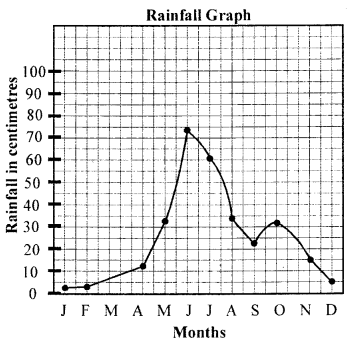
Practice Questions (Solved)
Question 1.
What do you understand by a ‘natural resource’ ?
Answer:
The things that we and other living organisms (plants and animals) required for living and provided as natural gifts are called natural resources.
Question 2.
How many kinds of natural resources are available ? Name them.
Answer:
There are two types of natural resources i.e. Renewable resources and Non-renewable resources. These are air, water, plants, sunlight which are renewable, some are soil, minerals which are Non-renewable in case of reckless exploitation.
Question 3.
What are the various uses of wood ?
Answer:
The wood is one of the most important resource, as it provides timber for houses, construction, fuel for household and industrial purposes, transport lines, agricultural implements, furniture, sports goods, stationery and various consumer goods.
Question 4.
Why are coal and petroleum called fossil fuels ?
Answer:
The coal is formed by compression of carboniferous age forests between impervious sedimentary rock-folds and the petroleum is the stored ‘body oil of dinosaurs of Jurassic period in between the impervious rocks within the poses of shale rocks. So these are called the fossil fuels on account of being buried within the rocks like the fossils for a long period under the pressure of tectonic forces.
Question 5.
What are the benefits of non-conventional sources of energy?
Answer:
Non-conventional sources of energy are solar, geothermal, tidal energies. These are perennial sources i.e. non-exhaustible or renewable resources which can be obtained for ever and are also pollution-free. Although the establishment and apparatus of these sources is quite costly, but their returns are life – long.
Question 6.
What is the difference between sea water and fresh water?
Answer:
Sea water is saline in which the percentage of salinity is 3.5% i.e. 35 (35 per thousand) but the fresh water is not saline and can be used for drinking, household and industrial purposes.
Question 7.
What is the total percentage of fresh water on the earth?
Answer:
Out of 100% Water bodies on the earth 97% is occupied by the oceans, and only 3% is comprised by fresh water, again out of this 2% is occupied by snow lands and only 1 % is taken by fresh water bodies e.g. ponds, lakes, rivers etc.
Question 8.
What is hydro logical cycle ?
Answer:
The water of ocean is evaporated in large amount into the atmosphere and then condensed into the clouds, fog, mist etc. After the dew point arises, precipitation takes place and fill up the fresh water bodies of the land surface. Again the water flow goes into the ocean and in this way a complete hydro logical cycle works on the earth. This is beneficial for the life on the earth, as fresh water is provided for agriculture and other occupations.
Question 9.
What gases does air contain ?
Answer:
Air mainly contains oxygen and nitrogen. Carbon dioxide and argon are also found in air.
Question 10.
Name the gases that are found in air along with their percentage.
Answer:
Oxygen 21 %, Nitrogen 78%, Argon 0.9%, others 0.1 %
Question 11.
Why is oxygen essential ?
Answer:
Oxygen is essential as it supports respiration making life possible on the earth.
Question 12.
How is carbon dioxide useful ?
Answer:
Carbon dioxide in the air is used by plants to produce food and oxygen.
Question 13.
How does an air conditioner help ?
Answer:
An air conditioner keeps the temperature and moisture of the air in a room at comfortable levels (usually between 20° and 25° C and a relative humidity of 35 – 70%).
Question 14.
name five resources which we get from the earth.
Answer:
Soil, minerals, coal, petroleum and plants.
Question 15.
What does subsoil contain ?
Answer:
Humus, rocks and minerals.
Question 16.
What are minerals ? List any four minerals.
Answer:
Minerals are inorganic substances obtained from Earth through the process of mining. Coal, manganese, iron ore and gold.
Question 17.
What type of resources are minerals ?
Answer:
Minerals are non-renewable natural resources which means that once mined, their deposits are depleted and lost forever without any chance of replenishment.
Question 18.
How do forests retain water ?
Answer:
Forests absorb rainwater and only gradually release it into rivers.
Question 19.
What is meant by deforestation ?
Answer:
Deforestation means cutting down and clearing of tree covers from forest areas to get land for agricultural use, cattle grazing . or exporting timber.
Question 20.
What happens when fossil fuels are burnt ?
Answer:
When fossil fuels are burnt they cause air pollution. Greenhouse gases are formed and acid rain may also fall.
Question 21.
List the inexhaustible sources of energy.
Answer:
Solar, hydel, tidal, wind and nuclear energy.
Question 22.
Which places in India can be used for tidal power generation ?
Answer:
Gulf of Cambay, Gulf of Kutch, Sunderbans and other coastal areas.
Question 23.
How many biogas plants have been set up in India under the National Biogas Development Programme ?
Answer:
15 lakh biogas plants.
Question 24.
What is geothermal energy ? Give examples of geothermal energy.
Answer:
It is the conversion of natural heat from the interior of the Earth to heat buildings and generate electricity. Volcanoes and natural springs.
Question 25.
How is ground water formed ?
Answer:
Water falls on earth in form of rain. The water from rainfall which reaches land percolates into the soil to reach deep down. Then it becomes a part of ground water.
Question 26.
List the advantages and disadvantages of solar energy.
Answer:
Solar energy can be gained by using a solar cell, a device that produces electricity directly from sunlight. By using special mirrors that focus the sunlight from a large area to a small area, solar-energy can be utilized for boiling water or for creating steam for producing electricity. The same collected solar energy can be localized into a solar furnace to heat oil. This process is used to boil water that drives turbines which produce electricity. Solar energy can be utilized to get drinking water from salty water sources. Salty water can be boiled and collected in form of steam. Salt, left behind is removed, and the steam gets cooler to turn back into water. Solar energy is used in desalination plant for this purpose. Photovoltaic cells have been used to electrify remote villages in rural Rajasthan, Uttar Pradesh, Gujarat and Haryana.
Solar energy has some disadvantages also, like the availability of sunlight only in daytime, lack of efficiency on a cloudy or rainy day, and feasibility only in countries located in regions which receive direct rays of the sun for a number of months in a year.
Question 27.
What is hydrological cycle ?
Answer:
Radiation from the sun causes water to evaporate from the water bodies in the form of water vapour. From plants, water continues to evaporate into air. This is done through the process of transpiration. Some water vapour is also retained by air. When the water vapour in the air rises up it combines to form clouds. In the clouds, there is moisture, i.e. water, which may fall on earth in form of rain, hail or snow. Some rain water that falls to the ground gets absorbed by the soil to form underground water.
The remaining water reaches the water bodies (river, ponds, lakes and oceans). This is the hydrological or water cycle that continues in nature all the time.
Question 28.
What is the aim of dividing the world into natural regions?
Answer:
The aim of dividing the world into natural regions is to study the variations in natural environment and its impact on human life in different parts of the world.
Question 29.
What forms the basis of a general scheme of natural regions of the world ?
Answer:
The latitudinal location and extent of an area forms the basis of a general scheme of natural regions.
Question 30.
Mention the regions that cover the following :
(a) Tropical Regions
(b) Warm Temperate Regions
(c) Cool Temperate Regions
(d) Polar Regions.
Answer:
(a) Tropical regions cover :
- Equatorial region
- Tropical grassland (savanna)
- Tropical desert
- Tropical east margin.
(b) Warm temperate regions cover :
- Mediterranean region
- China type
- Continental interior
(c) Cool temperate regions cover :
- Cool temperate west margin
- Temperate grasslands
- Cool temperate east margin
- Cool temperate (Taiga)
(d) Polar regions :
- Tundra (Cold desert)
- Ice caps
Question 31.
Where does the tropical region lie ?
Answer:
Tropical region lies roughly between 30°N and 30°S latitudes.
Question 32.
Where does the warm temperate region lie ?
Answer:
The warm temperate region lies between 30°North and South and 45° North and South of the Equator.
Question 33.
Where does the cool temperate region lie ?
Answer:
The cool temperate region lies roughly between 45° North and 65° North as well as between 45° South and 65° South latitudes.
Question 34.
Where does the polar region lie ?
Answer:
Polar region lies beyond 65° latitude (i.e., beyond Arctic and the Antarctic circles) and the Pole in each hemisphere.
Question 35.
Name the continents where the equatorial regions are situated.
Answer:
The continents where the equatorial regions are situated are – South America, Africa and Asia.
Question 36.
Which parts of Asia and S. America included in equatorial forest region.
Answer:
Equatorial region in Asia includes :
- Indonesia
- Malaysia
- Irian Jaya
- Papua New Guinea and
- The southern islands of Philippines
Equatorial region in South America includes :
- The Amazon basin
- The coastal lowlands between the Guyana and Brazilian highlands.
- The coastal part of Columbia.
Question 37.
Name the areas constituting the equatorial region in Africa.
Answer:
The areas constituting the equatorial region in Africa are :
- The Congo basin
- The coast of Guinea
- Southern parts of Nigeria and Ghana.
Question 38.
What are the chief features of the climate of equatorial regions ?
Answer:
Chief features of climate of equatorial region are :
- It receives a large amount of insolation.
- Relative humidity remains high throughout the year.
- Almost equal days and nights throughout the year.
- Little seasonal variation in the climatic conditions because of vertical sun rays all the year round.
- Climate is not unbearable because of cloudiness and heavy rainfall.
Question 39.
Mention the major trees found in equatorial forests.
Answer:
Major trees of equatorial forests are :
Mahogany, Ebony, Ivory wood, Dye wood, Cinchona and Rose wood.
Question 40.
Name any four countries which have monsoon climate.
Answer:
India, Pakistan, Bangladesh, Myanmar, etc. have monsoon climate.
Question 41.
Mention the location of Tropical monsoon type regions.
Answer:
Monsoon type regions are located in the zone extending between 5° and 30° latitudes on either side of the Equator.
Question 42.
What is the range of temperature in monsoon region in the interior of the continent.
Answer:
Summer temperature varies from 35°C to 38°C in the interior. Winter temperature varies from 15°C to 18°C in the interior.
Question 43.
Why is there complete reversal of pressure gradients over Asiatic landmass ?
Answer:
There is complete reversal of pressure gradients over Asiatic landmass because of north wards and southwards migration of the Sun and consequent differential heating of the continent and adjoining areas.
Question 44.
Name any two states of India which receive winter rainfall.
Answer:
The eastern coast of Tamil Nadu and Andhra Pradesh receives much rainfall during winter season through north-east monsoons.
Question 45.
What is the location of tropical desert ?
Answer:
Tropical deserts are located on the western coasts of the continents between the latitudes of 15° and 30° north and south in the belt of the trade winds.
They are found in both the hemispheres pole ward of the tropical grasslands.
Question 46.
Name the parts that Sahara desert covers.
Answer:
Sahara desert covers :
(a) Parts of Algeria
(b) Libya
(c) UAR (Egypt)
(d) Sudan
(e) Mali
(f) Niger and Chad.
Question 47.
Where are the following deserts located ?
(a) Arabian desert
(b) Thar desert
(c) Kalahari desert
(d) Atacama desert
Answer:
(a) Arabian desert is to the east of Red sea.
(b) Thar desert is in the Indian subcontinent.
(c) Kalahari desert is in southern parts of Africa.
(d) Atacama desert is in South America extending along the Pacific coast to the west of the Andes mountains.
Question 48.
Mention the two features of the climate of tropical desert.
Answer:
The two features of the climate of tropical desert are :
- Dry and hot
- Aridity is the most outstanding feature of these deserts.
Question 49.
State the vegetation of deserts.
Answer:
Vegetation of deserts :
- Cacti, thorny scrub and wiry grass, herbs, weed.
- The vegetation may not appear green and fresh all the time.
- Vegetation consist of entirely drought resisting plants – Xerophytes.
- Dwarf trees like acacia are found.
- Date palms are found near the oases.
Question 50.
Why are the deserts sparsely populated ?
Answer:
The deserts are sparsely populated because of the shortage of food and water.
Question 51.
Name the typical animal of desert region.
Answer:
Camel is the typical animal of desert region as it is especially well-adapted to the arid environment.
Question 52.
What is the location of Mediterranean region ?
Answer:
Mediterranean region is located on the western margins of the continents between 30 ° and 45 ° latitudes in both hemispheres.
It lies between the tropical deserts and cool temperate areas.
Question 53.
Mention the extent of Mediterranean type climate in the following :
(a) Asia
(b) Europe
(c) Africa
(d) America
(e) Australia
Answer:
Extent of Mediterranean type of climate is as follows :
(a) Asia includes :
- Turkey
- Syria
- Lebanon and Israel
(b) Europe includes :
- Spain
- Portugal
- Southern France
- Italy and Greece
(c) Africa includes :
- North-west Algeria
- Tunisia
- Morocco
- Egypt and Southern Strip of South Africa.
(d) North America includes west coast of USA (a large part of California)
(e) Australia includes :
- Southern and South-Western region
- North Island of New Zealand.
Question 54.
What are the general characteristics of the climate of Mediterranean region ?
Answer:
General characteristics of the climate of Mediterranean region are :
- A warm dry summer and a cool wet winter.
- It receive moderate amount of precipitation.
- Low humidity.
- It experience many local winds-hot and cold.
Question 55.
Name the winds prevailing during summers and winter in Mediterranean region.
Answer:
During summer trade winds blow upto about 45° N latitude in the Northern Hemisphere. In winter the prevailing winds are westerlies and reach the western coasts of the continents as onshore winds. Being moist these winds cause rainfall in winter season.
Question 56.
What are the characteristics of the Mediterranean climate which makes it suitable for orchard farming ? Which state of USA is famous for orchard farming ?
Answer:
The Mediterranean lands are the well known orchard lands of the world. The mild rainy winters and abundant sunshine, even in winter, have made these regions very suitable for fruit growing. The state of California is famous for orchard farming.
Question 57.
Which country is the world’s leading producer of grapes?
Answer:
Italy is the world’s leading producer of grapes.
Question 58.
Why is the Mediterranean region popular for fruit processing industry ?
Answer:
The easy availability of fruit as a raw material leads the development of fruit processing industry. The popularity of viticulture witnessed a revolution in the manufacturing industry especially in the production of wines.
Question 59.
Why Mediterranean region cannot support large cattle populations ?
Answer:
Climate conditions in the Mediterranean region do not favour grasses because most of the rain occurs in cool season when the growth is slow. The only grasses that can grow in these regions are so wiry and bunchy that they cannot support large cattle populations.
Question 60.
During which season Mediterranean region receives most of its rainfall.
Answer:
Mediterranean region receives most of the rainfall in winter season.
Question 61.
Give the important evergreen coniferous trees of Mediterranean region.
Answer:
Evergreen coniferous trees of Mediterranean region are :
- Pines
- Firs
- Cedars
- Cypresses.
Question 62.
For what is California famous and why ?
Answer:
California is famous for orchard farming. It is because of its climate, long frost free growing season and fertile alluvial soils. Moreover there are many irrigation projects which provide plentiful supply of water to the farm lands.
Question 63.
Mention three special cultures of Mediterranean region.
Answer:
Three special cultures of Mediterranean region are :
- Sericulture
- Horticulture
- Viticulture.
Question 64.
What is Viticulture ? Why is it so popular in Europe ?
Answer:
The cultivation of grapes is known as viticulture. This fruit is used for making wines of various brands and kinds. It is very popular in Europe because of its availability.
Question 65.
By what names are the grasslands known in following areas :
(a) In North America
(b) In South Africa
(c) In Hungary
(d) In Eurasia
(e) In Australia.
Answer:
The grasslands are known by different names in different areas :
(a) In North America as Prairies
(b) In South Africa as Veld
(c) In Hungary as Pastaz
(d) In Eurasia as Steppes
(e) In Australia as Downs.
Question 66.
Give the extent of steppes.
Answer:
Steppes extends from the east shore of the Black sea and Caspian sea to the Loess highland of north-west China, including the plain of Manchurian and Russian Turkestan.
Question 67.
What kind of climate does Steppe has ?
Answer:
It has continental climate. Extreme summer and winter temperatures.
- In Northern Hemisphere because of distance from sea summers are warm, winters are cold.
- In Southern Hemisphere climate is never severe. It is moderate because of nearness to sea.
Question 68.
What is the mean annual rainfall in Steppe region ?
Answer:
Mean annual rainfall in Steppe region is between 25 cm to 75 cm.
Question 69.
What is the extension of prairies ?
Answer:
Prairies extend from the Great Lakes to the Rocky mountains in Canada and the United States.
Question 70.
What is the average temperature and rainfall in prairies?
Answer:
The average temperature is 16°C and rainfall ranges between 50 and 75 cm.
Question 71.
Give the location of China type climate region.
Answer:
China type climatic region is located between 20° and 40° latitude in both the hemispheres along the eastern parts of the continents.
Question 72.
By which currents are the coastal parts of China type of climate affected ?
Answer:
The coastal parts of China type of climate are affected by the warm currents.
Question 73.
What are typhoons ?
Answer:
Typhoons are tropical cyclones which occur in China sea.
Question 74.
Give two characteristics of vegetation of China type climate.
Answer:
Dense forests of evergreen nature are found in more humid areas but areas of moderate rainfall are characterized by deciduous sparse forests and grasslands.
Question 75.
In which parts of Africa do tropical grasslands occur ?
Answer:
In the continent of Africa, the tropical grasslands are the most extensive, covering a belt around the Equatorial region in both the hemispheres.
Question 76.
What is known as ‘Parkland’ ?
Answer:
Some parts of tropical grasslands are known as ‘Parkland’ because there are clusters of trees, especially along river valleys and on the margins of the Equatorial region.
Question 77.
Why is the Taiga known as the Cold Pole of the Earth’?
Answer:
Taiga is known as the ‘Cold Pole of the Earth’ because Verkhoyansk (-68° C), the ‘Cold Pole’ of the world is located in this region in Eastern Siberia. It is a basin where the cold air stagnates for many weeks. It has the distinction of being the coldest place in the world.
Question 78.
Why is Polar Tundra region called the cold desert ?
Answer:
The Polar Tundra region is called the cold desert because the annual rainfall is less than 25 cm.
Give reasons for the following
Question 79.
There is little seasonal variation in the climatic condition of equatorial region.
Answer:
Due to almost vertical sun rays all the year round, there is little seasonal variation in the climatic conditions.
Question 80.
Equatorial regions support luxuriant vegetation.
Answer:
Equatorial regions support luxuriant vegetation because of high temperature and abundant rainfall.
Question 81.
Nights in the deserts are very cold.
Answer:
Temperature remains some what lower due to the influence of cold currents during night. Clear skies also cause a rapid cooling of the land at night.
Question 82.
Camel is called the ship of the desert.
Answer:
Camel is called the ship of desert because it has,adapted itself to the harsh environment of the desert in the following ways :
- Its long legs with padded feet enable it to move fast over sand.
- It can store water in its body for a number of days.
- Its hump stores energy in the form of fat on which it can survive during times of starvation.
- It is capable of picking very small leaves from even thorny bushes.
- It has good capacity to carry loads.
Question 83.
Mediterranean regions receive most of their precipitation in winter season.
Answer:
In winter the prevailing winds are westerlies and they reach the western coasts of the continents as onshore winds. Being moist they cause precipitation on the western margin of the continents.
Question 84.
Climate conditions in the Mediterranean region do not favour grasses.
Answer:
Climatic conditions in the Mediterranean region do not favour grasses because most of the rain occurs in cool season when the growth is slow.
Question 85.
Agriculture is the main occupation of the people in most parts of the Mediterranean lands.
Answer:
Agriculture is the main occupation of the people in Mediterranean region. Long growing season, long hours of bright sunshine, the high temperature of summer, mid moist winters and fertile soils, in many areas, are favorable conditions for the growth of certain crops.
Question 86.
Grasslands are treeless.
Answer:
Grasslands are treeless because the porous soil and low rainfall mostly in summer. High evaporation and swift winds check the growth of trees in these regions.
Question 87.
The Steppe climate of the southern hemisphere is never severe rather it is moderate.
Answer:
The Steppe climate of the southern hemisphere is never severe rather it is moderate because of nearness to the sea.
Question 88.
The western margins of continents are extremely dry.
Answer:
The western margins of continents are extremely dry because the trade winds blow from the interior of continents as offshore winds.
Differentiate between the following
Question 89.
Humid regions and Sub-humid regions.
Answer:
Humid regions :
- Humid regions receive more precipitation than the evaporation all the year round.
- These regions face no water deficiency in the dry season.
Sub-humid regions :
- In a sub-humid regions the precipitation exceeds evaporation only during the short rainy season.
- These regions face water deficiency in the dry season.
Question 90.
Humid regions and Arid regions.
Answer:
Humid regions :
- Humid regions receive more precipitation than the evaporation all the year round.
- No water scarcity.
Arid regions :
- Arid regions precipitation is lower than the precipitation whole year.
- Water scarcity throughout the year.
Question 91.
Warm temperate region and Cool temperate region.
Answer:
Warm temperate region :
- It extends from 30° N to 45° N latitudes in each hemisphere.
- It includes Mediterranean type, tropical desert type and monsoon type climatic region.
Cool temperate region :
- It extends from 45° N latitudes in each hemisphere.
- It includes west-European type, temperate grasslands, St. Lawrence type and Taiga type climatic region.
Question 92.
Sericulture and Viticulture.
Answer:
Sericulture :
- Sericulture refers to the rearing of silk worms.
- It is for. the production of raw silk. Leading producers are Northern Italy, Southern France and Parts of Spain.
Viticulture :
- Viticulture refers to growing of grapes on a large scale.
- It is for the production of wine. Leading producers are Italy, France, Spain and Portugal.
Question 93.
Truck farming and orchard farming.
Answer:
Truck farming :
- The American farmers call ‘market gardening’as truck farming because they send fruits and vegetables daily to the markets by means of truck
- Climatic condition is not an important factor in truck farming.
Orchard farming :
- Mediterranean lands are the well-known orchard lands of the world. Orchard farming is concerned with growing of fruits on large scale.
- Climatic condition is the main factor in orchard farming so lots of care is needed at every stage.
Question 94.
Evergreen and Xerophytic trees of Mediterranean region.
Answer:
Evergreen trees :
- Evergreen trees of Mediterranean region have no regular season for shedding their leaves.
- They have needle shaped leaves.
- Pines, firs, cedars and cypresses are the main evergreen trees of this region.
Xerophytic trees :
- Xerophytic trees of Mediterranean region they adapt themselves to the dry summer.
- They have small, stiff, shiny leaves, thorns and long roots and waxy surface.
- The vine (with long roots) laurel (with leathery leaves), cork oak with thick spongy bark are some examples of this region.
Question 95.
Role of trade winds and westerlies in Mediterranean region.
Answer:
Role of trade winds in Mediterranean region :
- Trade winds prevail during summer.
- These blow up to about 45° latitude.
- These blow from an easterly quarter and become dry by the time they reach the western margins of the continents, cause no rainfall.
Role of westerlies in Mediterranean region :
- Westerlies prevail during winter season.
- These blow between 30° N latitudes.
- These reach the western coasts as onshore winds. Being moist they cause precipitation on the western margin of the continents.
Question 96.
Steppes and Prairies.
Answer:
Steppes :
- The grasslands in Eurasia are known as Steppes.
- The Steppes of Eurasia occur on either side of the Ural mountains covering the parts of Eastern Europe and Western Siberia in Asia.
Prairies :
- The grasslands in North America are known as Prairies.
- Prairies of North America lie between the Rockies and the Great Lakes of North America.
Question 97.
Define Mangrove forest.
Answer:
Mangrove forest: These forests are found in the coastal areas and brackish swamps. The number of plant species found in any area in these forests are very large.
Question 98.
Define Shifting cultivation
Answer:
Shifting cultivation : It is a migratory system of agriculture. In this system, at first the small trees of an area are cut by a long thick bladed knife then, the slash is burnt, and crops are planted among the stumps by dropping the seeds into holes, made with a pointed stick.
Question 99.
Define Oases
Answer:
Oases : Oases are the areas in the deserts where some water is available. They are centers of greenery in the otherwise dreary expanse of the desert.
Question 100.
Define Sericulture
Answer:
Sericulture : It is an art of raising the silkworms and production of raw silk. Northern Italy, Southern France and parts of Spain are leading produces of silk in Europe.
Long Answer Questions
Question 101.
(a) Give a brief account of climate of the Equatorial region.
(b) Explain briefly the importance of Equatorial forests.
(c) Why are Equatorial forests not commercially important?
Answer:
(a) The Equatorial region is characterized by uniform high temperature and heavy rainfall throughout the year. This is why there is little seasonal variation in climatic conditions in this region.
- This kind of climatic condition is due to the high angle of incidence of the Sun’s rays. The angle of incidence varies only between 66 V2° and 90° during the year.
- Temperature ranges between 25° C and 30° C with an annual range of about 2° C.
- Rainfall is well distributed during all the months of the year. The amount ranges from 150 cm to 350 cm or more. Rainfall is of Convectional origin. The intense heating of the atmosphere due to solar radiation causes convectional ascent of air leading to cooling of air condensation, formation of clouds and rainfall in the afternoon. But the mountain regions experience Orographic rainfall.
- Thus the equatorial region has the combination of high temperature and high humidity but the climate is not unbearable because of cloudiness and heavy rainfall.
(b) Equatorial forests are important in many ways as :
- They are very vital for our environment because they absorb a large amount of carbon dioxide from the atmosphere and exhale huge amount of oxygen. Hence they are known as the ‘Lungs of the world’.
- They maintain the ecological balance so their destruction will adversely affect the ozone layer and cause a great harm to living beings.
- They are the source of numerous medicinal plants and herbs, e.g., Quinine is obtained from cinchona tree growing in these forests.
- They are a source of valuable hard wood timber like Mahogany, Ebony, Ironwood, Rosewood, etc.
(c) Equatorial forests are not commercially important because of the following reasons :
- Equatorial forests are dense and have a large number of varieties of trees in mixed strands. Pure strands of trees are not found as in the coniferous forests.
- Valuable species are found scattered over a large area.
- The ground in damp and slushy and the construction of roads, railway line is difficult.
- The climate is also oppressive due to high temperature, high humidity and heavy rainfall.
Question 102.
Explain the monsoon climate type region under the following heads :
(a) Temperature
(b) Air pressure and winds
(c) Vegetation
(d) Three seasons of Indian subcontinent.
Answer:
Monsoon climate type region under :
(a) Temperature : In summer, when the Sun is overhead on the Tropic of Cancer, the Northern Hemisphere is intensely heated. Summer temperature varies from 27°C to 30° C in the coastal areas and 35° C to 38° C in the interior.
- In winter, the Sun is overhead on the Tropic of Capricorn. Temperature varies from 22° C to 25° C in the coastal areas and 15° C to 18° C in the interior.
- In some northern parts of India the temperature during May and June becomes exceptionally high due to prevalence of hot winds locally known as loo.
(b) Air pressure and winds.
- (i) The low pressure is strong enough to attract the moisture bearing winds from the Indian ocean.
- (ii) The South East Trade winds from the Southern Hemisphere are drawn into India as the South-West monsoon winds after they cross the Equator.
- (iii) Monsoon areas are affected by high and low pressure systems due to winter and summer seasons respectively.
- (iv) There is complete reversal of pressure gradients over Asiatic landmass.
(c) Vegetation. Important trees :
- Sal
- Teak
- Bamboo
- Mahua
- Jamun
- Neem
- Shisham, etc.
Trees are normally deciduous because of the marked dry season during which they shed their leaves to withstand the drought.
Forests are more open, less luxuriant. Tidal forests grow in Delta plains and along the coasts. The Sunderbans of Ganga – Brahamputra delta are famous mangrove forests.
(d) There are three main seasons in a year in Indian sub continent.
- The hot, dry season is from March to mid June. During this period temperature is very high. Sun’s apparent movement is northwards to Tropic of Cancer. Relative humidity is low. Coastal region experiences some relief from the intense heat due to the moderating influence of the sea. Dust storms are very common in the northern region.
- Humid warm summer season is also known as the rainy season which is from July to October. The maximum rainfall is concentrated in these months. Due to rains the temperature is considerably low.
- Dry winter season from November to February. During this period North-East monsoon prevails. Winds are dry but over the Bay of Bengal they pick up moisture which is deposited in south-east Indian peninsula.
Question 103.
(a) Elaborate the special features of vegetation in hot desert region.
(b) What is the mode of rainfall in hot desert region.
Answer:
(a) The hot deserts are not good for vegetation due to climatic conditions. The rainfall is too scanty to support a vegetable cover. Therefore a lot of bare ground on desert land.
- The type of vegetation growing here consists of thorny scrubs like cactus, prickly pear and other plants which are adapted to survive in a region of low rainfall. These are called Xerophytic plants.
- Some species have thick leathery leaves, some are leafless while some plants have a repugnant smell so that they are not eaten by animals.
- Cacti are the most typical plants of the deserts. The Saguaro Cactus in the Arizona Desert (USA) is the famous cactus.
- The date palm grows best only in hot deserts as it requires plenty of sunshine and sandy soil. Date palms are grown near the oases where under ground water occurs near the surface.
(b) The hot deserts receive less than 25 cm of annual rainfall, on the average, but many places do not get even this because the hot deserts are located on western margins of continents and in the belt of Trade Winds. The trade winds become drier because the moisture gets precipitated on the eastern margins. The western margins are extremely dry because the Trade winds are blown from the interior of continents as offshore winds. The trade winds blow from cooler higher latitudes to warmer lower latitudes. Hence the winds gets warmed up and the possibility of rainfall is reduced. Rainfall occurs as torrential downpours associated with violent thunderstorms due to convectional ascent of air.
Question 104.
The Mediterranean land is known as the ‘Land of Orchards’. In this context answer the questions that follow :
(a) The characteristics of Mediterranean climate.
(b) How is it suitable for orchard farming ?
Answer:
(a) Characteristics of Mediterranean climate are as follows : These regions lie between the Tropical Deserts on the equatorward and cool temperate west margin region polewards. So the Mediterranean regions are characterised by warm, dry summer and cool wet winters.
- It receives a moderate amount of precipitation as it is transitional between the arid and the humid regions.
- The coastal regions are cooler than the interior ones due to the influence of cool ocean currents.
- The humidity is low so the heat of the day is not felt oppressive.
- The Mediterranean regions experience moderate rainfall only in winter and drought in summer. The annual rainfall varies from about 35 cm to 75 cm.
- During the summer season, the North-East and South-East Trade winds prevail over this region. As these offshore winds are hot and dry, they blow dust from the adjoining desert regions.
- During the winter season, this region is under the influence of the moist Westerlies blowing from the oceans. It gives much rainfall.
- It experiences many local winds – hot and cold. The southern shores of Mediterranean sea are affected by hot and dry winds, called the Sirocco, which blow from the Sahara desert and carry a large amount of dust. The high temperature of the wind damages vine yards, olive trees and vegetable crops.
- The hot and dry wind is known by many local names such as Khamsin in Egypt, Leveche in Spain and Santa Ana in California
- Cold local winds called the Mistral descend from the Alpine range during the winter season and blow with great force which damage cultivated crops and trees.
- A similar type of cold wind, called Bora, often causes devastation.
- Clear sky and sunshine are common almost throughout the year.
- Snowfall is very rare in this region except on mountains.
(b) Mediterranean land is suitable for orchard farming because of suitable climate. Orchard farming is important on the slopes which are not suitable for the cultivation of food crops. Fruit orchards cover large areas of hill slopes as citrus fruits trees have a deep root system to tap underground water. The climatic conditions of this region, the warm sunny summer, helps in ripening them. The mild rainy winters and abundant sunshine, even in winter have made these regions Very suitable for fruit growing. The dry season favour the harvest. Moisture deficiencies are avoided through good network of canals.
Some of the common citrus fruits are orange, lemon, lime and grape fruit. Other varieties are olives, grapes, peach, pear, plum, pomegranate, apricot and fig. Chestnut walnut, hazelnut and almond are also grown. Because of large scale fruit growing Mediterranean lands are the orchards of the world.
